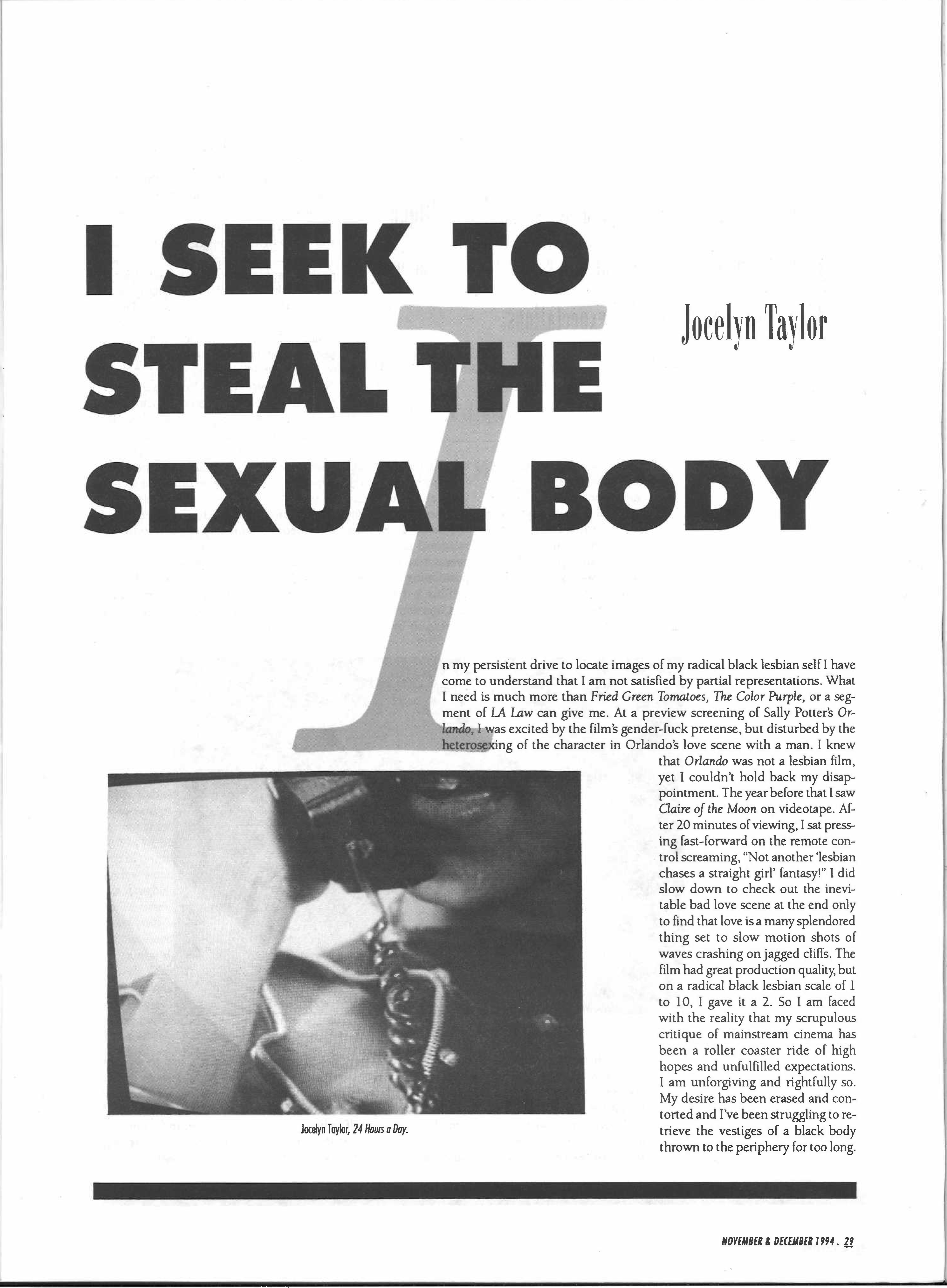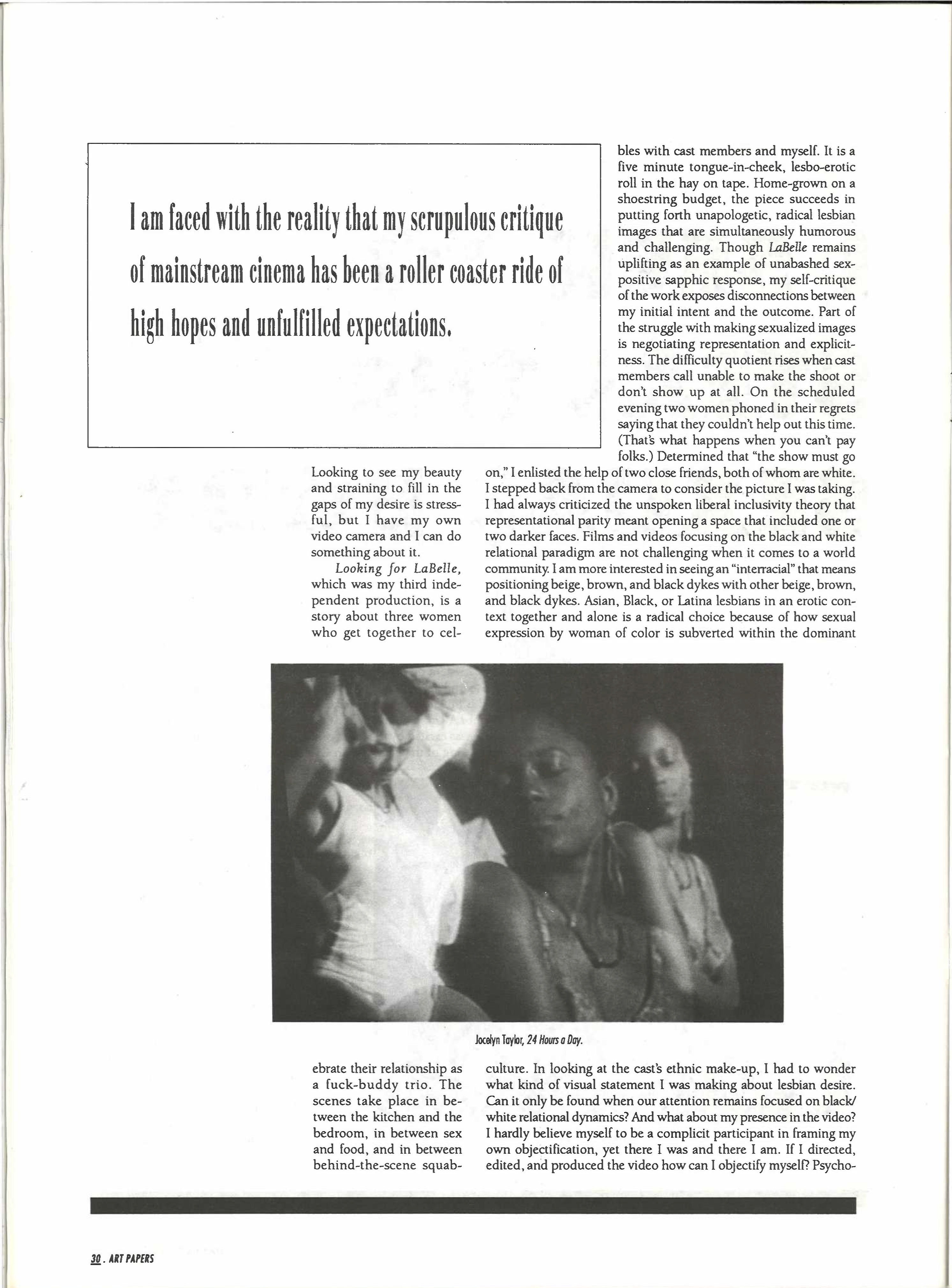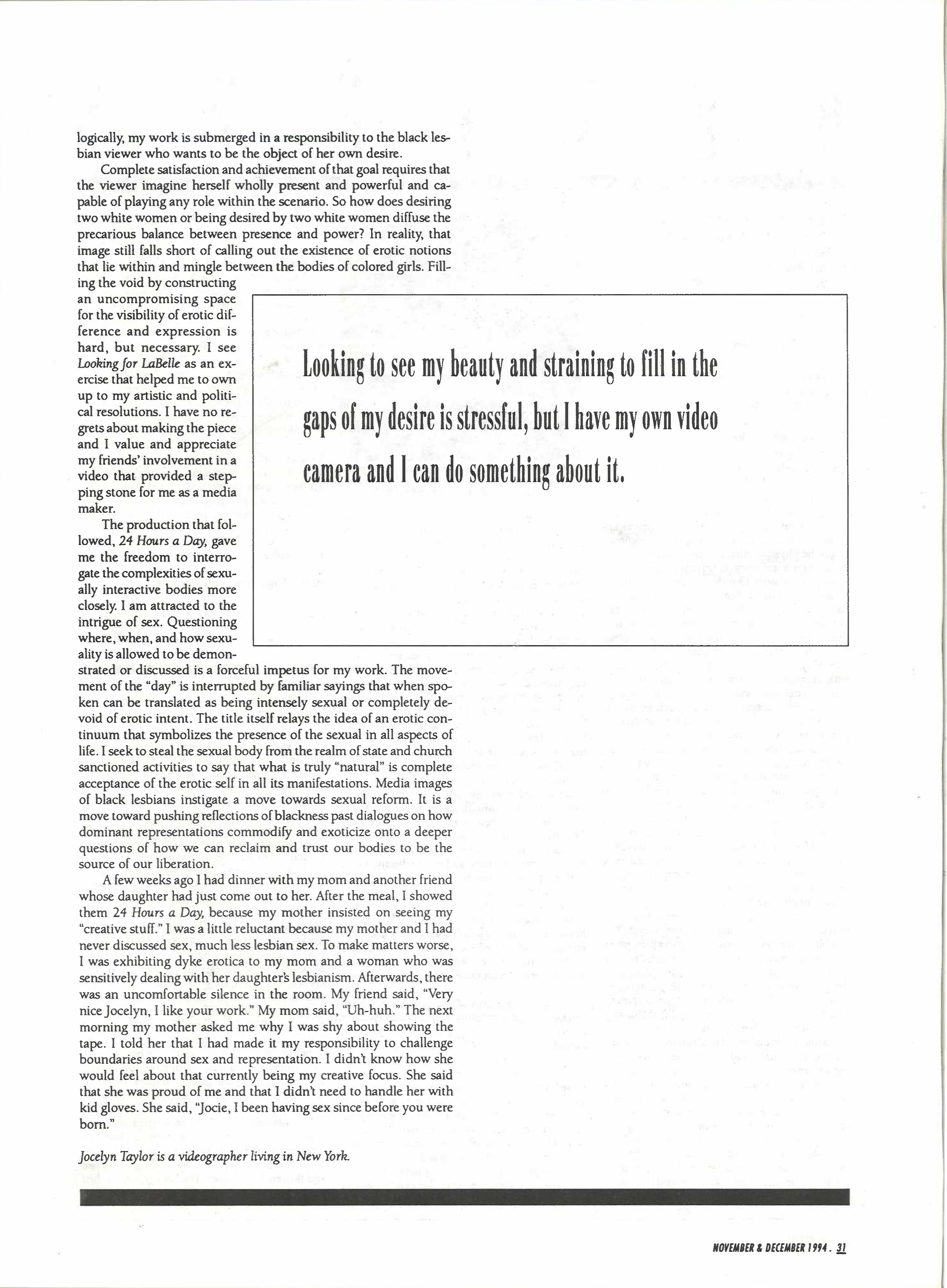I Seek to Steal the Sexual Body
Share:
This feature originally appeared in ART PAPERS November/December 1994
In my persistent drive to locate images of my radical black lesbian self I have come to understand that I am not satisfied by partial representations. What I need is much more than Fried Green Tomatoes, The Color Purple, or a segment of LA Law can give me. At a preview screening of Sally Potter’s Orlando, I was excited by the film’s gender-fuck pretense, but disturbed by the heterosexing of the character in Orlando’s love scene with a man. I knew that Orlando was not a lesbian film, yet I couldn’t hold back my disappointment. The year before that I saw Claire of the Moon on videotape. After 20 minutes of viewing, I sat pressing fast-forward on the remote control screaming, “Not another ‘lesbian chases a straight girl’ fantasy!” I did slow down to check out the inevitable bad love scene at the end only to find that love is a many splendored thing set to slow motion shots of waves crashing on jagged cliffs. The film had great production quality, but on a radical black lesbian scale of 1 to 10, I gave it a 2. So I am faced with the reality that my scrupulous critiques of mainstream cinema has been a rollercoaster ride of high hopes and unfulfilled expectations. I am unforgiving and rightfully so. My desire has been erased and contorted and I’ve been struggling to retrieve the vestiges of a black body thrown to the periphery for too long. Looking to see my beauty and straining to fill in the gaps of my desire is stressful, but I have my own video camera and I can do something about it.
Looking for LaBelle, which was my third independent production, is a story of three women who get together to celebrate their relationship as a fuck-buddy trio. The scenes take place in between the kitchen and the bedroom, in between sex and food, and in between behind-the-scene squables with cast members and myself. It is a five minute tongue-in-cheek, lesbo-erotic roll in the hay on tape. Home-grown on a shoestring budget, the piece succeeds in putting forth unapologetic, radical lesbian images that are simultaneously humorous and challenging. Though LaBelle remains uplifting as an example of unabashed sex-positive sapphic response, my self-critique of the work exposes disconnections between my initial intent and the outcome. Part of the struggle with making sexualized images is negotiating representation and explicitness. The difficulty quotient rises when case members call unable to make the shoot or don’t show up at all. On the scheduled evening two women phoned in their regrets saying they couldn’t help out this time. (That’s what happens when you can’t pay folks.) Determined that “the show must go on,” I enlisted the help of two close friends, both of whom are white. I stepped back from the camera to consider the picture I was taking. I had always criticized the unspoken liberal inclusivity theory that representational parity meant opening a space that included one or two darker faces. Films and videos focusing on the black and white relational paradigm are not challenging when it comes to a world community. I am more interested in seeing an “interracial” that means positioning beige, brown, and black dykes with other beige, brown, and black dykes. Asian, Black, or Latina lesbians in an erotic context together and alone is a radical choice because of how sexual expression by woman of color is subverted within the dominant culture. In looking at the cast’s ethnic make-up, I had to wonder what kind of visual statement I was making about lesbian desire. Can it only be found when our attention remains focused on black/white relational dynamics? And what about my presence in the video? I hardly believe myself to be a complicit participant in framing my own objectification, yet there I was and there I am. If I directed, edited, and produced the video how I can objectify myself? Psychologically, my work is submerged in a responsibility to the black lesbian viewer who wants to be the object of her own desire.
Complete satisfaction and achievement of that goal requires that the viewer imagine herself wholly present and powerful and capable of playing any role within the scenario. So how does desiring two white women or being desire by two white women diffuse the precarious balance between presence and power? In reality, that image still falls short of calling out the existence of erotic notions that lie within and mingle between the bodies of colored girls. Filling the void by constructing an uncompromising space for the visibility of erotic difference and expression is hard, but necessary. I see Looking for LaBelle as an exercise that helped me to own up to my artistic and political resolutions. I have no regrets about making the piece and I value and appreciate my friends’ involvement in a video that provided a stepping stone for me as a media maker.
The production that followed, 24 Hours a Day, gave me the freedom to interrogate the complexities of sexually interactive bodies more closely. I am attracted to the intrigue of sex. Questioning where, when, and how sexuality is allowed to be demonstrated or discussed is a forceful impetus for my work. The movement of the “day” is interrupted by familiar sayings that when spoken can be translated as being intensely sexual or completely devoid of erotic intent. The title itself relays the idea of an erotic continuum that symbolizes the presence of the sexual in all aspects of life. I seek to steal the sexual body from the realm of state and church sanctioned activities to say that what is truly “natural” is complete acceptance of the erotic self in all its manifestations. Media images of black lesbians instigate a move towards sexual reform. It is a move toward pushing reflections of blackness past dialogues on how dominant representations commodify and exoticize into deeper questions of how we can reclaim and trust our bodies to be the source of our liberation.
A few weeks ago I had dinner with my mom and another friend whose daughter had just come out to her. After the meal, I showed them 24 Hours a Day, because my mother insisted on seeing my “creative stuff.” I was a little reluctant because my mother and I had never discussed sex, much less lesbian sex. To make matters worse, I was exhibiting dyke erotica to my mom and a woman who was sensitively dealing with her daughter’s lesbianism. Afterwards, there was an uncomfortable silence in the room. My friend said, “Very nice Jocelyn, I life your work.” My mom said, “Uh-huh.” The next morning my mother asked me why I was shy about showing the tape. I told her that I had made it my responsibility to challenge boundaries around sex and representation. I didn’t know how she would feel about that currently being my creative focus. She said that she was proud of me and that I didn’t need to handle her with kid gloves. She said, “Jocie, I been having sex since before you were born.”
Jocelyn Taylor is a videographer living in New York.


